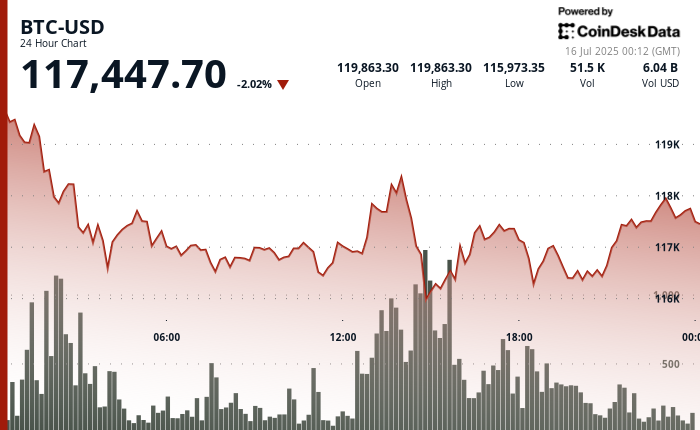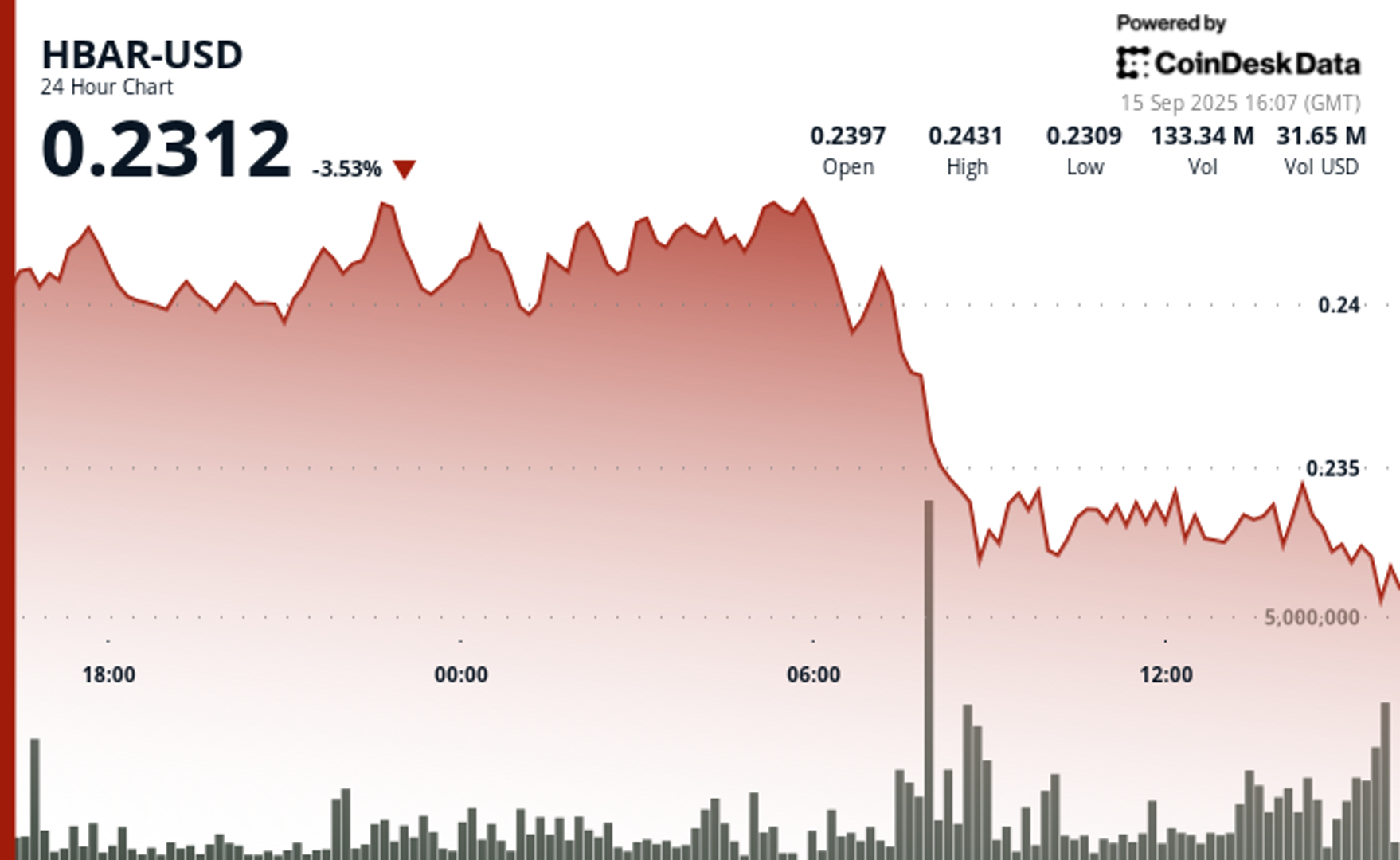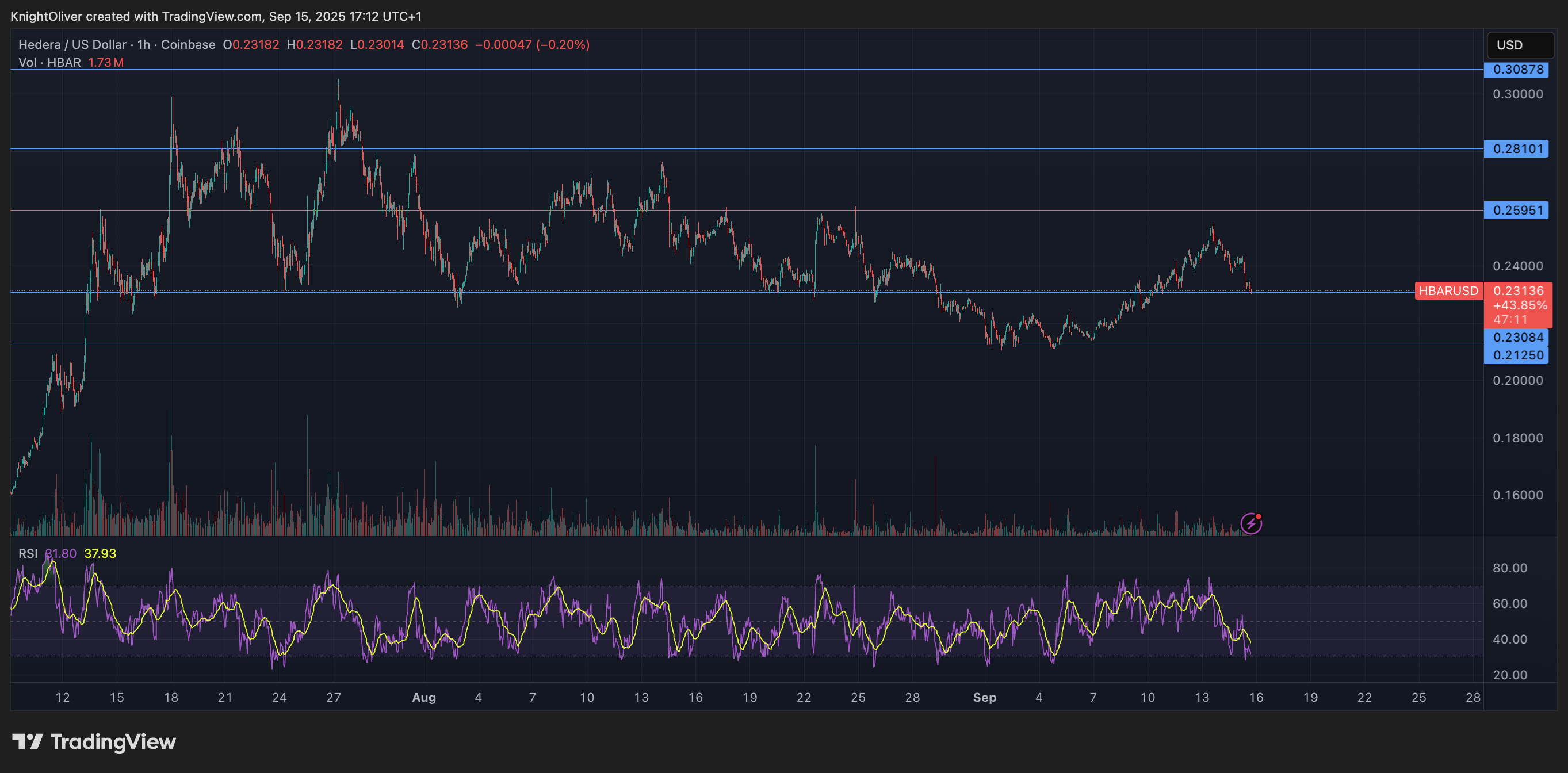Uncategorized
Asia Morning Briefing: BTC Pulls Back as Market Isn’t ‘Invincible’, But Google, Meta Lift AI Tokens

Good Morning, Asia. Here’s what’s making news in the markets:
Welcome to Asia Morning Briefing, a daily summary of top stories during U.S. hours and an overview of market moves and analysis. For a detailed overview of U.S. markets, see CoinDesk’s Crypto Daybook Americas.
As East Asia begins its business day, bitcoin is down 1.8%, trading above $117,800, as traders take some profit after BTC pushed through multiple all-time highs.
While there’s a belief from some market participants that the rally is just beginning, with calls for BTC to hit 160k, 200k, and further, OKX’s Chief Commercial Officer, Lennex Lai warns that risk is building just as fast as market enthusiasm.
«Across platforms, we’re seeing an increase in aggressive long positions and widening funding rates as ‘Crypto Week’ headlines boost sentiment,» Lai told CoinDesk in an interview via Telegram. «At these levels, risks can build quickly — escalation of trade tensions with the EU, Mexico, and other trading partners could trigger sharp corrections. Another risk is letting euphoria drive decisions.»
Lai points to a slate of coming macro announcements – like the U.K. CPI release, and the U.S Core PPI, retail sales, and consumer sentiment, that could influence global risk sentiment and set the tone for broader markets.
These concerns echo findings from K33 Research’s H1 2025 market report, which highlighted similar risks and volatility triggers earlier this year.
According to K33, geopolitical turmoil and trade policy uncertainty have already driven significant market swings, such as a 30% correction to $75,000 earlier in the year.
The report specifically noted, «Bitcoin struggled in this de-risking period but showed subtle hints of relative strength vs equities by outperforming equities in the aftermath of Liberation Day.»
Additionally, K33 highlighted historically low funding rates amidst rising prices, signaling cautious sentiment among seasoned traders who remain wary of abrupt market reversals.
«Annualized funding rates averaged at 4.51% throughout the half-year, the lowest average half-year funding rate since December 31, 2022,» when the post-FTX crypto winter was at its coldest, the report said.
«In moments like this, smart traders focus on strategy over sentiment, using discipline to manage risk,» Lai continued. «The excitement at the top is real, but those who manage their entries, exits, and funding exposure carefully are best positioned for whatever comes next.»
After all, he concluded, «strong momentum doesn’t mean the market is invincible.»

Maple Finance is Crypto’s Largest On-Chain Asset Manager
Maple Finance is now the largest on-chain asset manager, overtaking BlackRock’s tokenized money market fund BUIDL, according to data from a Dune Analytics dashboard tracking real-time DeFi asset flows. A surge of over $100 million in new deposits this week pushed Maple’s total assets under management (AUM) to $2.9 billion, eclipsing BUIDL’s $2.3 billion.
While BUIDL draws capital with its ultra-conservative exposure to short-term U.S. Treasuries and cash equivalents, Maple appeals to more risk-tolerant institutions by offering yield through undercollateralized loans to vetted trading firms and crypto-native borrowers. That model, which relies on delegated credit underwriting rather than blanket overcollateralization, now appears to be scaling faster.
The milestone suggests a growing appetite for yield-bearing DeFi credit products amid continued macro uncertainty. It also marks a rare instance where a decentralized credit protocol has outpaced a major TradFi incumbent like BlackRock on-chain, at least by raw AUM.
AI Tokens Rally as Big Tech Doubles Down on Infrastructure
AI-focused crypto tokens jumped 5% overnight, pushing the sector’s market cap to $29.6 billion, according to CoinGecko. The move comes amid a surge of AI and data infrastructure announcements from major U.S. tech firms, sparking renewed investor enthusiasm across both equity and token markets.
Google said Tuesday it will invest $25 billion into data centers and AI infrastructure across the PJM electric grid, America’s largest, while also agreeing to buy 3,000 megawatts of hydroelectric power via a $3 billion deal with Brookfield. Meta, meanwhile, is planning “hundreds of billions” in AI data center builds, including a multi-gigawatt facility called Prometheus in Ohio.
The announcements were timed around a Trump administration-led summit at Carnegie Mellon University, where over $90 billion in AI, energy, and data infrastructure pledges were revealed. The bullish tone on AI, from both government and industry, appears to be spilling into token markets, at least for now.
Market Movements:
BTC: Bitcoin is trading at $117,810.33, down 1.69%, and failed breakout attempts gave way to high-volume support, narrowing consolidation, and thinning liquidity, signaling market exhaustion and anticipation ahead of the next macro catalyst, according to CoinDesk’s Research’s technical analysis data.
ETH: Ethereum surged 2.6% to $3,066.57 in a volatile 24-hour session, rebounding from a $2,933.50 low as institutional flows, record staking, and strong volume fueled a breakout past $3,075, signaling renewed bullish momentum.
Gold: Gold fell 0.56% to $3,331.55, even as a new London Bullion Market Association (LBMA) poll showed analysts turning more bullish with upgraded 2025 forecasts averaging $3,324.40—driven by geopolitical tensions, dollar weakness, and fiscal concerns, though opinions remain split on whether prices will climb toward $4,000 or fade into year-end.
Nikkei 225: Asia-Pacific markets are set to open mixed after President Trump announced a preliminary trade deal with Indonesia that includes a 19% U.S. tariff on its exports.
S&P 500: The S&P 500 edged 0.4% lower after touching an intraday record, as rising Treasury yields and a 2.7% June inflation reading raised concerns over tariff-driven price pressures, despite strong bank earnings and Nvidia-led tech gains.
Elsewhere in Crypto:
Uncategorized
Wall Street Bank Citigroup Sees Ether Falling to $4,300 by Year-End

Wall Street giant Citigroup (C) has launched new ether (ETH) forecasts, calling for $4,300 by year-end, which would be a decline from the current $4,515.
That’s the base case though. The bank’s full assessment is wide enough to drive an army regiment through, with the bull case being $6,400 and the bear case $2,200.
The bank analysts said network activity remains the key driver of ether’s value, but much of the recent growth has been on layer-2s, where value “pass-through” to Ethereum’s base layer is unclear.
Citi assumes just 30% of layer-2 activity contributes to ether’s valuation, putting current prices above its activity-based model, likely due to strong inflows and excitement around tokenization and stablecoins.
A layer 1 network is the base layer, or the underlying infrastructure of a blockchain. Layer 2 refers to a set of off-chain systems or separate blockchains built on top of layer 1s.
Exchange-traded fund (ETF) flows, though smaller than bitcoin’s (BTC), have a bigger price impact per dollar, but Citi expects them to remain limited given ether’s smaller market cap and lower visibility with new investors.
Macro factors are seen adding only modest support. With equities already near the bank’s S&P 500 6,600 target, the analysts do not expect major upside from risk assets.
Read more: Ether Bigger Beneficiary of Digital Asset Treasuries Than Bitcoin or Solana: StanChart
Uncategorized
XLM Sees Heavy Volatility as Institutional Selling Weighs on Price

Stellar’s XLM token endured sharp swings over the past 24 hours, tumbling 3% as institutional selling pressure dominated order books. The asset declined from $0.39 to $0.38 between September 14 at 15:00 and September 15 at 14:00, with trading volumes peaking at 101.32 million—nearly triple its 24-hour average. The heaviest liquidation struck during the morning hours of September 15, when XLM collapsed from $0.395 to $0.376 within two hours, establishing $0.395 as firm resistance while tentative support formed near $0.375.
Despite the broader downtrend, intraday action highlighted moments of resilience. From 13:15 to 14:14 on September 15, XLM staged a brief recovery, jumping from $0.378 to a session high of $0.383 before closing the hour at $0.380. Trading volume surged above 10 million units during this window, with 3.45 million changing hands in a single minute as bulls attempted to push past resistance. While sellers capped momentum, the consolidation zone around $0.380–$0.381 now represents a potential support base.
Market dynamics suggest distribution patterns consistent with institutional profit-taking. The persistent supply overhead has reinforced resistance at $0.395, where repeated rally attempts have failed, while the emergence of support near $0.375 reflects opportunistic buying during liquidation waves. For traders, the $0.375–$0.395 band has become the key battleground that will define near-term direction.

Technical Indicators
- XLM retreated 3% from $0.39 to $0.38 during the previous 24-hours from 14 September 15:00 to 15 September 14:00.
- Trading volume peaked at 101.32 million during the 08:00 hour, nearly triple the 24-hour average of 24.47 million.
- Strong resistance established around $0.395 level during morning selloff.
- Key support emerged near $0.375 where buying interest materialized.
- Price range of $0.019 representing 5% volatility between peak and trough.
- Recovery attempts reached $0.383 by 13:00 before encountering selling pressure.
- Consolidation pattern formed around $0.380-$0.381 zone suggesting new support level.
Disclaimer: Parts of this article were generated with the assistance from AI tools and reviewed by our editorial team to ensure accuracy and adherence to our standards. For more information, see CoinDesk’s full AI Policy.
Uncategorized
HBAR Tumbles 5% as Institutional Investors Trigger Mass Selloff

Hedera Hashgraph’s HBAR token endured steep losses over a volatile 24-hour window between September 14 and 15, falling 5% from $0.24 to $0.23. The token’s trading range expanded by $0.01 — a move often linked to outsized institutional activity — as heavy corporate selling overwhelmed support levels. The sharpest move came between 07:00 and 08:00 UTC on September 15, when concentrated liquidation drove prices lower after days of resistance around $0.24.
Institutional trading volumes surged during the session, with more than 126 million tokens changing hands on the morning of September 15 — nearly three times the norm for corporate flows. Market participants attributed the spike to portfolio rebalancing by large stakeholders, with enterprise adoption jitters and mounting regulatory scrutiny providing the backdrop for the selloff.
Recovery efforts briefly emerged during the final hour of trading, when corporate buyers tested the $0.24 level before retreating. Between 13:32 and 13:35 UTC, one accumulation push saw 2.47 million tokens deployed in an effort to establish a price floor. Still, buying momentum ultimately faltered, with HBAR settling back into support at $0.23.
The turbulence underscores the token’s vulnerability to institutional distribution events. Analysts point to the failed breakout above $0.24 as confirmation of fresh resistance, with $0.23 now serving as the critical support zone. The surge in volume suggests major corporate participants are repositioning ahead of regulatory shifts, leaving HBAR’s near-term outlook dependent on whether enterprise buyers can mount sustained defenses above key support.

Technical Indicators Summary
- Corporate resistance levels crystallized at $0.24 where institutional selling pressure consistently overwhelmed enterprise buying interest across multiple trading sessions.
- Institutional support structures emerged around $0.23 levels where corporate buying programs have systematically absorbed selling pressure from retail and smaller institutional participants.
- The unprecedented trading volume surge to 126.38 million tokens during the 08:00 morning session reflects enterprise-scale distribution strategies that overwhelmed corporate demand across major trading platforms.
- Subsequent institutional momentum proved unsustainable as systematic selling pressure resumed between 13:37-13:44, driving corporate participants back toward $0.23 support zones with sustained volumes exceeding 1 million tokens, indicating ongoing institutional distribution.
- Final trading periods exhibited diminishing corporate activity with zero recorded volume between 13:13-14:14, suggesting institutional participants adopted defensive positioning strategies as HBAR consolidated at $0.23 amid enterprise uncertainty.
Disclaimer: Parts of this article were generated with the assistance from AI tools and reviewed by our editorial team to ensure accuracy and adherence to our standards. For more information, see CoinDesk’s full AI Policy.
-

 Business11 месяцев ago
Business11 месяцев ago3 Ways to make your business presentation more relatable
-

 Fashion11 месяцев ago
Fashion11 месяцев agoAccording to Dior Couture, this taboo fashion accessory is back
-

 Entertainment11 месяцев ago
Entertainment11 месяцев ago10 Artists who retired from music and made a comeback
-

 Entertainment11 месяцев ago
Entertainment11 месяцев ago\’Better Call Saul\’ has been renewed for a fourth season
-

 Entertainment11 месяцев ago
Entertainment11 месяцев agoNew Season 8 Walking Dead trailer flashes forward in time
-

 Business11 месяцев ago
Business11 месяцев ago15 Habits that could be hurting your business relationships
-

 Entertainment11 месяцев ago
Entertainment11 месяцев agoMeet Superman\’s grandfather in new trailer for Krypton
-

 Entertainment11 месяцев ago
Entertainment11 месяцев agoDisney\’s live-action Aladdin finally finds its stars





